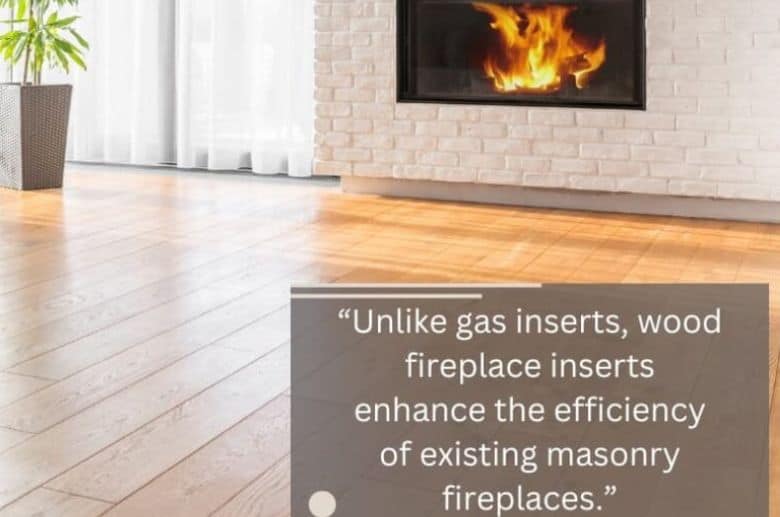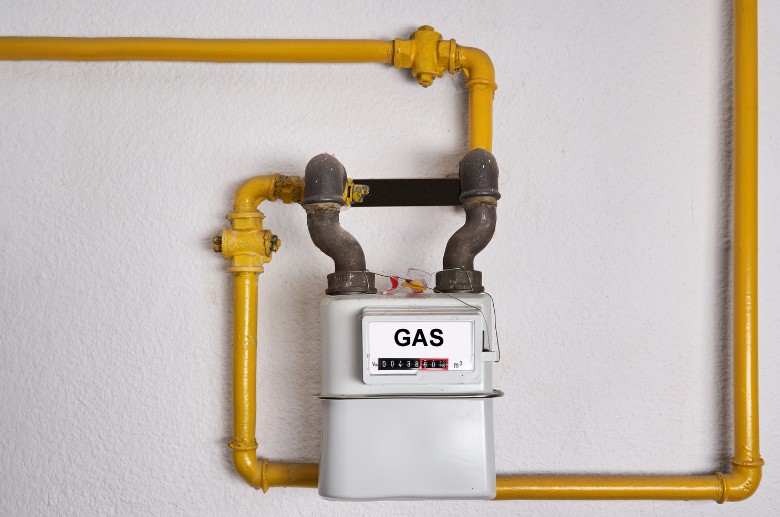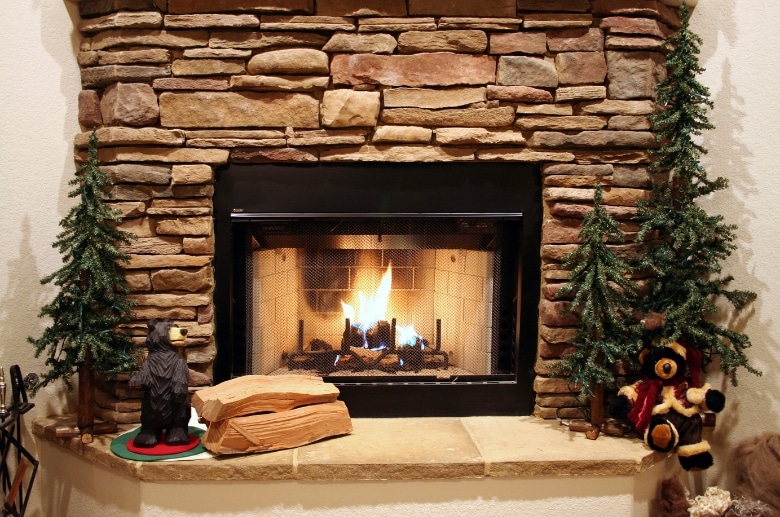Fireplace inserts have become a popular choice for property owners looking to enhance their existing fireplaces’ warmth, aesthetics, and functionality. These inserts are an efficient and cost-effective way to transform old, inefficient wood or gas fireplaces into a more practical and visually appealing heating source.
Regarding fireplace inserts, two of the most popular options are gas fireplace inserts and wood inserts. But are they all the same? In this comprehensive guide, we decipher the difference between gas insert vs wood insert.
We also discuss the key aspects of both types, including cost, aesthetics, and more, which will help you make the right choice.
How Do Gas Fireplace Inserts Work?

To understand how a gas fireplace insert operates, it’s important to look at the different features that make it possible.
Fuel Source
Gas fireplace inserts operate on natural or liquid propane gas, offering a modern and efficient alternative to traditional wood fireplaces. These inserts efficiently convert existing wood-burning fireplaces into clean, convenient heating sources.
Burner and Ignition Systems
At their core, gas fireplace inserts have a carefully crafted burner system made from stainless steel or cast iron, creating realistic flames and heat. These inserts feature an ignition mechanism, often electronic, that generates sparks to ignite the gas, ensuring a hassle-free start.
Safety and Ventilation Systems
Safety is paramount, with oxygen depletion sensors (ODS) monitoring oxygen levels and automatic shut-offs for pilot light failure. Proper ventilation is also crucial to expel combustion byproducts safely.
——
Do You Need to Hire Chimney & Fireplace Expert?
Get free quotes from qualified experts near you. No commitment required!
——
Control and Heat Distribution Systems
Gas inserts have versatile control systems, allowing adjustments via switches, knobs, remotes, or smartphone apps. This gives you precise control over flame height and heat output.
To maximize efficiency, built-in fans or blowers distribute warm air evenly throughout the room, while some models employ heat exchangers to capture and redistribute exhaust heat.
How Do Wood Fireplace Inserts Work?

Unlike gas inserts, wood fireplace inserts enhance the efficiency of existing masonry fireplaces. They fit snugly into the fireplace, isolating the firebox and maximizing heat retention. Below, we look at how wood fireplace inserts work:
Fuel Source and Air Supply
These inserts rely on seasoned firewood as their primary fuel source, promoting efficient burning with lower moisture content. A carefully engineered air intake system enables controlled combustion by regulating oxygen flow, allowing users to manage burn rates and heat output.
Combustion Chamber and Heat Exchange Systems
A specialized combustion chamber within the insert ensures efficient burning with minimal smoke and particulate emissions. Heat exchange systems capture the generated heat, redistributing it into the room through fans or heat exchangers.
These inserts also include ash management features, simplifying maintenance by collecting and facilitating the disposal of ash and residues.
Venting and Control
Proper venting is essential, with stainless steel liners connecting the insert to the existing chimney, ensuring the safe expulsion of smoke and combustion gases.
One of the challenges of this system is that you have limited control over the heat. You’ll be required to adjust the air intake or add wood logs to achieve the desired burn rates, which can be tiresome.
Gas Insert vs Wood Insert Comparison
Before we explore the comparison between gas inserts and wood inserts, let’s first examine the following:
Factors to Consider When Choosing an Insert
There are various factors you’ll need to consider when selecting an insert. However, the most common ones include the following:
- Fuel source
- Efficiency
- Maintenance
- Aesthetics
Differences Between Gas Fireplace Inserts and Wood Inserts
Here, we’ll highlight three key differences between gas and wood fireplace inserts to help you make an informed choice:
Fuel Type

Gas fireplace inserts operate on either natural gas or propane, providing instant and convenient heat at the push of a button. In contrast, wood fireplace inserts use seasoned firewood, offering the quintessential wood-burning experience with a real fire’s aroma and crackling sounds.
Efficiency and Maintenance
Gas fireplace inserts are known for their efficiency, precise control over heat output and minimal maintenance requirements. They produce consistent heat and have a lower environmental impact due to cleaner combustion.
On the other hand, wood inserts require more effort and maintenance, including loading wood, tending to the fire, and cleaning ashes and the chimney. While wood fires offer a timeless charm, they demand more hands-on involvement and may be less efficient in terms of heat output and emissions.
Aesthetics and Ambiance
Gas fireplace inserts offer a clean, controlled flame with the option of realistic log sets, providing a convenient and tidy solution. In contrast, wood inserts deliver an authentic wood-burning experience, with the mesmerizing dance of flames and the scent of burning wood.
——
Do You Need to Hire Chimney & Fireplace Expert?
Get free quotes from qualified experts near you. No commitment required!
——
How Can Gas Fireplace Inserts Be Retrofitted Into Existing Wood-Burning Fireplaces?
Retrofitting is a practical and relatively straightforward endeavor. However, you must contact a professional to help you with the job. Here’s what to expect from the chimney expert during the retrofitting process:
1. Measuring and Inspection
Before installation, the expert will carefully measure the dimensions of the existing fireplace to ensure a proper fit for the gas insert. An inspection will also assess the chimney’s and flue’s condition. Necessary repairs or modifications are made at this stage.
2. Installation of Gas Line
If a natural gas line is unavailable, one will be installed from a nearby source. A gas tank or cylinder may be added for propane to facilitate burning. Remember, proper gas line installation is crucial for safe and efficient operation.
3. Venting System
After installing the gas line, the expert will install a venting system to safely route combustion byproducts outside the home, such as carbon monoxide.
Depending on the model, this may involve a direct vent, which draws in outside air for combustion and vents exhaust gases outdoors, or a vent-free system equipped with a catalytic converter for indoor use.
4. Insert Placement
Afterward, the gas fireplace insert is placed within the existing fireplace, effectively sealing off the wood-burning firebox. This maximizes heat retention and enhances safety and efficiency.
5. Gas Connection and Ignition System
The gas insert is then connected to the gas line, and the ignition system is set up. Electronic ignition systems, remote controls, or wall switches offer ease of use and control.
With that in mind, let’s dive into the comparison between gas inserts vs. wood inserts:
1. Insert Cost
On average, gas inserts range from $5,500 to $7,000, while wood inserts are generally priced between $4,000 and $6,000. The price difference is primarily due to the complexities of gas systems and ignition mechanisms in gas inserts.
Installation Costs
Regarding installation costs, gas inserts may accrue additional expenses, including installing a gas line or flue, which typically ranges from $700 to $3,000.
On the other hand, wood inserts may require a chimney or opening modifications, costing between $300 and $800. These costs can vary based on the existing infrastructure in your home.
Operating Cost
Wood inserts are generally more cost-effective to run long-term. You can expect to purchase a cord of wood from $120 to $180, lasting up to 3 months. In contrast, natural gas will cost you around $0.40 per hour of operation, which is costly compared to wood.
Efficiency
Efficiency is a significant consideration for cost-effectiveness. Gas inserts tend to have higher efficiency ratings, averaging around 90%. Wood inserts, while still efficient at around 83%, have a slightly lower heat output per unit of fuel.
Maintenance Cost
Maintenance costs for both types of inserts are relatively similar. Wood inserts may require more frequent cleaning and servicing, costing between $130 and $300. Gas inserts are generally easier to maintain and may incur costs ranging from $100 to $200.
The maintenance costs for gas inserts are often lower due to their cleaner-burning nature and fewer components requiring servicing.
2. Insert Efficiency
Wood inserts typically provide a wide range of heat output, varying from 30,000 to 85,000 BTUs (British Thermal Units) per hour. This variability allows you to choose an insert that meets your heating needs. Gas inserts offer a more limited heat output range, typically between 20,000 and 40,000 BTUs per hour.
However, gas inserts have an edge when it comes to energy efficiency. They often boast up to 90% ratings, with wood inserts having 83%. This means gas inserts lose only about 10% of heat through the exhaust. This is unlike wood inserts, which lose a bit more heat, with around 20% lost in the exhaust gases.
3. Insert Installation
Wood inserts generally entail a simpler installation process. While they may require chimney or opening modifications, these alterations are typically less intricate than installing a gas line and venting system.
Also, wood inserts rely on natural airflow for combustion, eliminating the need for electrical wiring or gas connections.
4. Insert Lifespan and Durability
Wood inserts are known for their resilience and can typically last anywhere from 20 to 25 years when properly maintained. While offering efficiency and convenience, gas inserts tend to have a shorter average lifespan, ranging from 10 to 15 years.
However, these estimates can vary based on several factors, including the materials used during construction, the frequency and intensity of use, and environmental conditions like exposure to moisture, humidity, and extreme temperature fluctuations.
5. Insert Ambiance

Both wood and gas inserts offer unique ambiance qualities. Wood inserts provide real flames, the crackling of burning wood, a distinctive aroma, and radiant warmth. While offering artificial flames, gas inserts operate quietly, have no noticeable odor, and allow for customizable flame brightness.
Nevertheless, the choice between the two depends on your preference for authenticity, sensory experience, and convenience in creating the perfect ambiance for your home.
6. Insert Maintenance
Maintenance requirements for wood and gas inserts differ significantly, encompassing cleaning and regular check-ups.
Cleaning
Wood inserts involve more substantial maintenance, which includes the regular removal of ash, soot, and creosote buildup from the firebox and chimney. This process can be labor-intensive due to the residues generated by burning wood.
Conversely, gas inserts only require periodic cleaning to remove dust and debris that can accumulate around the gas log sets and burner. However, this cleaning is typically less intensive and does not involve dealing with ash or creosote buildup, contributing to a more straightforward upkeep process.
——
Do You Need to Hire Chimney & Fireplace Expert?
Get free quotes from qualified experts near you. No commitment required!
——
Regular Check-ups
For gas inserts, check-ups involve inspecting gas lines and valves to detect potential leaks or issues that may compromise safety or performance.
For wood inserts, chimney and flue inspections are required to assess their condition and ensure proper venting.
7. Insert Safety
Ensuring the safety of your home and family takes precedence when evaluating fireplace inserts, whether they operate on gas or wood-burning fuel. Below, we look at the safety considerations for both types of inserts:
Risk Factors
Both inserts produce carbon monoxide and other harmful fumes during combustion. As a result, proper installation, maintenance, and safety features are essential for mitigating this risk.
Moreover, wood inserts pose a risk of sparks and flying ashes escaping from the firebox. Hence, installing a quality spark guard or screen can help prevent these hazards from reaching your living space.
Safety Features
Both systems are equipped with venting systems to expel combustion byproducts safely. Gas inserts often use direct venting, drawing in outside air for combustion and venting exhaust gases outdoors.
Wood inserts rely on proper chimneys and flue systems to vent smoke and fumes safely.
They also have safety glass fronts that remain cool, reducing the risk of burns or accidental contact with the flames. These glass fronts provide additional protection, especially in homes with children or pets.
Control System
Gas inserts typically offer advanced control systems that precisely adjust flame height and heat output. Some models include safety features like automatic shut-off in the event of a malfunction or overheating, enhancing the overall safety of gas inserts.
This is unlike wood inserts, whose safety largely relies on proper operation and maintenance. Users must be vigilant in managing the fire, using seasoned wood, and maintaining the chimney to prevent creosote buildup, which can lead to fires.
8. Insert Convenience
Gas inserts are easy to use with straightforward on/off controls, often operated by a switch or button, and a continuous gas supply that eliminates manual fuel replenishment.
Temperature control is equally hassle-free, with options like thermostats and remote controls ensuring consistent and effortless heating. Precise flame adjustment adds convenience, allowing you to tailor the ambiance to your liking.
In contrast, wood inserts require more manual involvement. Ignition involves fire starters and kindling; ongoing maintenance includes regular wood feeding. Temperature control is also limited, as the heat output depends on the type and amount of wood burned, necessitating more hands-on adjustments.
9. Insert Aesthetic and Design
Both inserts come in various styles and models, catering to various design preferences.
For example, gas inserts offer diverse styles and models, from traditional to contemporary, with customizable finishes and accessories.
Wood inserts also present various design options, allowing you to choose between classic and modern looks while emphasizing the beauty of a natural wood fire. They also offer customization for surrounding materials, including stone, wood, or other finishes, and the choice of firebox liners and panels to match your preferences.
Nonetheless, we highly recommend that you consider the dimensions of the insert to your room size and space availability to ensure a seamless fit within your home’s decor.
Here’s a table summarizing the key points from the comparison items discussed above for gas and wood fireplace inserts.
| Aspect | Gas Insert | Wood Insert |
| Cost | $5,500 to $7,000 (Average) | $4,000 to $6,000 (Average) |
| Efficiency | 90% | 83% |
| Installation | $500 – $1,200 | $300 – $800 |
| Lifespan and Durability | 10-15 years | 20-25 years |
| Ambience | Artificial flames, quiet, no odor | Real flames, crackling, wood aroma |
| Maintenance | Cleaning and servicing cost $100 – $200 on average | Cleaning and servicing $130 – $300 on average |
| Safety | Safer | Less safe |
| Convenience | Easy on/off, continuous fuel supply | Manual ignition and loading |
| Insert Aesthetic and Design | Variety of styles and models | Variety of styles and models |
The Winner
When deliberating between a gas insert vs wood insert, it’s important to consider the unique benefits of each. Gas inserts offer unparalleled convenience thanks to their easy controls, low maintenance requirements, and the ability to precisely adjust temperature and flame intensity. They are particularly well-suited for modern households prioritizing efficiency and hassle-free heating solutions.
Conversely, wood inserts provide the charming authenticity of a real wood fire experience. Crackling flames and the delightful aroma of burning wood create a timeless ambiance that many find irresistible.
Ultimately, the winner in the gas insert vs. wood insert debate depends on what aligns best with your lifestyle, desired ambiance, and willingness to commit to maintenance.






